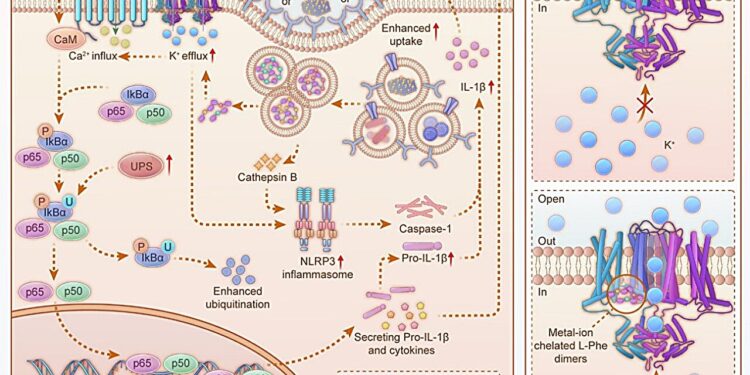Schematic illustration of enhanced tumor immunotherapy using DC therapy mediated by L-phenylalanine nanocomplexes chelated by metal ions. Credit: Natural nanotechnology (2024). DOI: 10.1038/s41565-024-01758-3
Immune checkpoint blockade (ICB) is one of the main methods of antitumor immunotherapy. However, clinical data have shown that only a portion of patients respond to ICB treatment. Since the tumor immunosuppressive environment plays a crucial role in ICB treatment, finding ways to effectively remodel this environment and increase the response rate to ICB treatment has become a key goal.
In a study published in Natural nanotechnologyA research team led by Professor Wang Hai and Nie Guangjun from the National Center for Nanoscience and Technology of the Chinese Academy of Sciences, in collaboration with Professor Ran Haitao from Chongqing Medical University, has developed three types of nanostructures that combine L-phenylalanine with metal ions.
This innovative design can effectively remodel the tumor immunosuppressive environment and significantly improve the efficacy of ICB immunotherapy.
Dendritic cells (DCs) play a crucial role in the immune response against cancer and infections. Mature DCs are essential for the activation of tumor-specific immunity. Over the last decade, two main activation pathways have been discovered to induce DC maturation and trigger the initial immune response: pathogen-associated molecular patterns (PAMPs) and damage-associated molecular patterns (DAMPs).
In addition to these danger signals, many functions of dendritic cells, including maturation, cytokine production, and migration, are also regulated by electrical signals in the body. The concentration of potassium and calcium ions in dendritic cells is closely related to their maturation process. However, the movement of metal ions in and out of cells is strictly controlled by ion channels, and there is currently no effective way to activate these channels.
To activate potassium ion channels on the DC membrane, the researchers used magnesium ions, iron ions, and zinc ions to coordinate with L-phenylalanine, creating three types of nanostructures: nanospheres (Ph-Mg), nanoneedles (Ph-Fe), and nanosheets (Ph-Zn). They found that these nanomaterials could enter cells through pinocytosis and caveolae-mediated endocytosis, but were unstable in acidic environments.
Computer simulations showed that the disassembled nanostructures would be released as dimers of L-phenylalanine chelated by metal ions. These dimers can bind to the S4 transmembrane region of the potassium ion channel (Kv1.3), thereby causing a change in the Kv1.3 structure, widening the channel and activating the potassium ion channel.
The outflow of potassium ions, together with the influx of calcium ions triggered by depolarization, activate the calmodulin-regulated NF–κB signaling pathway, promoting DC maturation and triggering the secretion of pro-inflammatory cytokines.
In addition, the researchers found that the uptake of nanostructures by dendritic cells can induce the release of cathepsin B, which, together with the release of potassium ions, activates the inflammasome pathway closely related to dendritic cell maturation. They showed that nutritional restriction could enhance the uptake of nanomaterials by dendritic cells, upregulate the expression of calmodulin, and degrade IkBα, thereby further strengthening the NF–κB pathway.
“Currently, most protein regulation focuses on the development of inhibitors. Finding ways to activate protein functions remains a challenge,” said Professor Wang, lead author of this study. “Fortunately, we found that the use of nanomedicine can precisely activate the potassium channel Kv1.3 in dendritic cells. This activation reverses the immunosuppressive environment of the tumor and improves the efficacy of immune checkpoint inhibitors.”
Researchers have developed nanostructures of metal ions and amino acids capable of regulating ion channel structures, thereby promoting the activation of the innate immune response by adjusting potassium and calcium ions in dendritic cells. This reshapes the immunosuppressive environment of the tumor, offering a new strategy to improve the efficacy of ICB therapy.
More information:
Mixiao Tan et al., Metal ion-chelating phenylalanine nanostructures reverse immune dysfunction and sensitize breast tumor to immune checkpoint blockade, Natural nanotechnology (2024). DOI: 10.1038/s41565-024-01758-3
Provided by Chinese Academy of Sciences
Quote:Use of metal ion-linked nanostructures to enhance immune response and boost breast tumor treatment (2024, August 29) retrieved August 29, 2024 from
This document is subject to copyright. Apart from any fair dealing for the purpose of private study or research, no part may be reproduced without written permission. The content is provided for informational purposes only.



